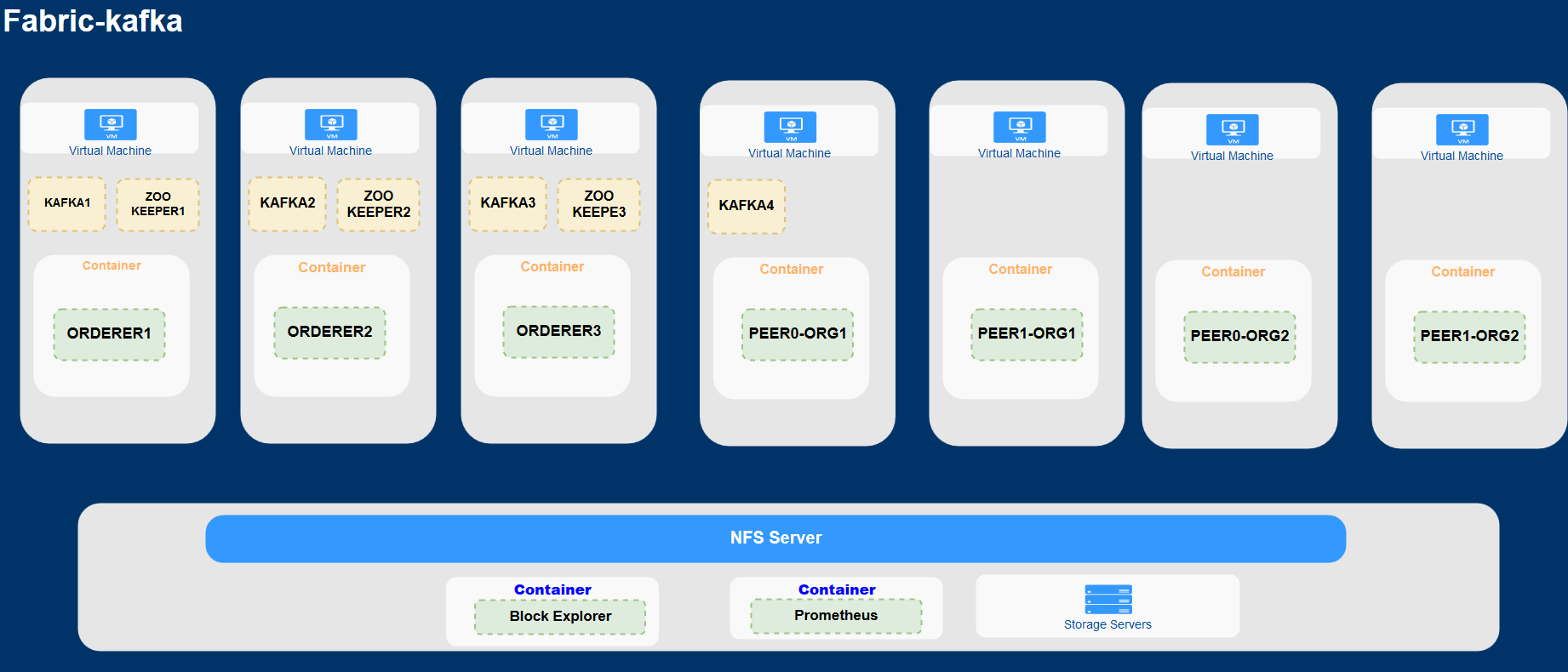
This article will configure kafka zookeeper cluster and explore the leader election process. We will configure a hyperledger blockchain using kafka cluster to understand this topic.
In this deployment We will standup Multi Node Apache Kafka/Zookeeper Cluster with 3 zookeeper nodes and 4 kafka nodes. After deployment we will use kafka related commands and Gui tools to verify the cluster has created the topics as per the model we configured. Finally we will verify the leader election process by bringing down one of the nodes.
We will be deploying the Hyperledger Blockchain network consisting of two organization, maintaining two peers each, there orderers using Docker and then deploy the ‘kafka’ ordering service deployed on VM. We will create a channel , join peers to the channel , install chaincode on peer and instantiate chaincode on channel. Also invoke transactions against the deployed chaincode.
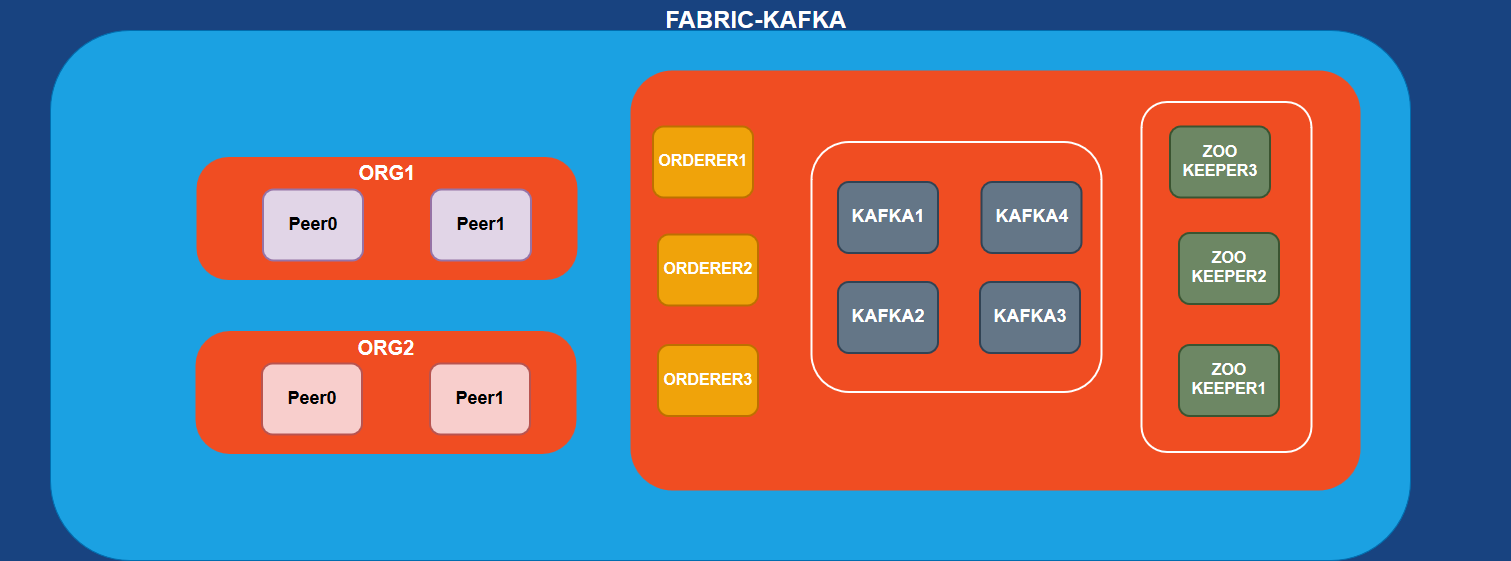
Fabric Deployment Model
For this deployment will be using multiple Virtual hosts. We will be deploy multi node kafka/zookeepr cluster on virtual hosts and docker containers for ordereres and peers. We will use Nfs server for accessing network artifacts across the hosts .In the end we will also deploy Hyperledger Block explorer .Refer above for the Network topology this article follows .
Server Configurations
- Configure your NFS file server VM and mount the NFS share on all the nodes by adding entries to /etc/fstab.
- Configure 3 zookeeper nodes and 4 Kafka nodes follow the reference link.
- In the kafka/config directory these are the two config files of interest. server.properties , zookeeper.properties
- Make the following changes in the server.properties file for each node:
- The value of the broker.id property should be changed such that it is unique throughout the cluster.
- The value of the zookeeper.connect property should be changed such that all nodes point to the same ZooKeeper instance. This property specifies the Zookeeper instance’s address and follows the HOSTNAME01/IP_ADDRESS01:2181, HOSTNAME02/IP_ADDRESS02:2181 ,format.
- Make sure to add the below setting to server.properties as per the Fabric documentation
############################# Additional Orderer Settings #############################
unclean.leader.election.enable=false
min.insync.replicas=2
default.replication.factor=3
replica.fetch.max.bytes=103809024
message.max.bytes=103809024
#The value 103809024=99 * 1024 * 1024B Based on Orderer.AbsoluteMaxBytes in configtx.yaml
- Make the following changes in the zookeeper.properties file for each node
clientPort=2181
clientPortAddress=HOSTNAME01/IP_ADDRESS01
# zoo servers
server.1=HOSTNAME01/IP_ADDRESS01:2888:3888
server.2=HOSTNAME02/IP_ADDRESS02:2888:3888
server.3=HOSTNAME03/IP_ADDRESS02:2888:3888
Start Zookeeper Nodes and then Kafka Nodes
kafka/bin/zookeeper-server-start.sh -daemon kafka/config/zookeeper.properties
kafka/bin/kafka-server-start.sh -daemon kafka/config/server.properties
Verify Brokers are up.
Install kafkat on one of the nodes .It is a simplified command-line administration for Kafka brokers refer the git repo for instructions.
Run command kafkat brokers to verify all brokers are up.

Generate the Network Artifacts
Generate the network artifacts using crypto-config.yaml ,configtx.yaml .Verify the configtx.yaml has set the properties OrdererType: kafka and has listed all the kafka brokers.
If you intent to modify the network topology, change the configuration files (.yaml files) appropriately.
bin/cryptogen generate --config=./crypto-config.yaml
bin/configtxgen -profile SampleDevModeKafka -channelID rtr-sys-channel -outputBlock ./channel-artifacts/genesis.block
export CHANNEL_NAME=rtrchannel01
bin/configtxgen -profile TwoOrgsChannel -outputCreateChannelTx ./channel-artifacts/channel.tx -channelID $CHANNEL_NAME
bin/configtxgen -profile TwoOrgsChannel -outputAnchorPeersUpdate ./channel-artifacts/Org1MSPanchors.tx -channelID $CHANNEL_NAME -asOrg Org1MSP
bin/configtxgen -profile TwoOrgsChannel -outputAnchorPeersUpdate ./channel-artifacts/Org2MSPanchors.tx -channelID $CHANNEL_NAME -asOrg Org2MSP
NFS Share
Copy (or use bind) the files from network artifacts , crypto and chaincode directory and *.yaml files to NFS share.(we will be sharing (use bind) fabric-kafka directory in this demonstration)
-
Start the network
Now lets start the network by running docker scripts from the Nfs share directory on the respective hosts.
cd opt/share/fabric-kafka VM1- docker-compose -f docker-compose-orderer1.yaml up -d VM2- docker-compose -f docker-compose-orderer2.yaml up -d VM3- docker-compose -f docker-compose-orderer3.yaml up -d VM4- docker-compose -f docker-compose-peer0-org1.yaml up -d VM5- docker-compose -f docker-compose-peer1-org1.yaml up -d VM6- docker-compose -f docker-compose-peer0-org2.yaml up -d VM7- docker-compose -f docker-compose-peer1-org2.yaml up -dOrderer logs at this point would show orderer.consensus.kafka related logs of Topic creation, setup of producers and consumers for the system channel specified during config.
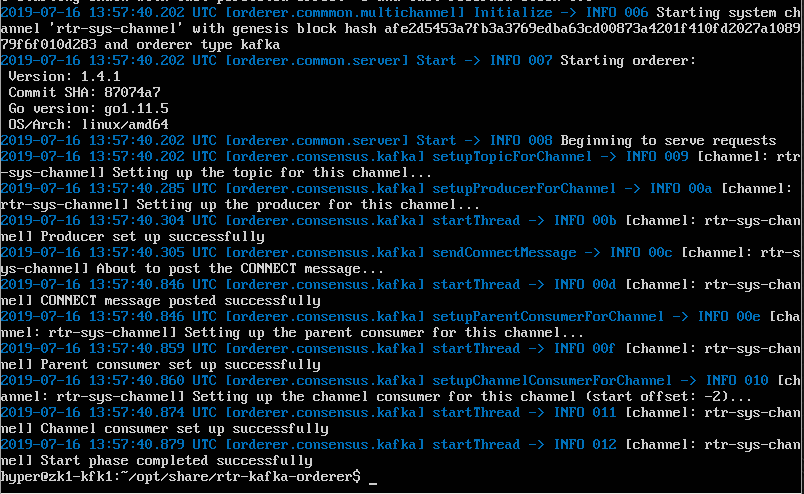
Orderer logs
Create channel and join the peers
#VM4 docker exec -it cli bash # Create channel export CHANNEL_NAME=rtrchannel01 peer channel create -o orderer1.fabric.com:7050 -c $CHANNEL_NAME -f ./channel-artifacts/channel.tx --outputBlock ./channel-artifacts/rtrchannel01.block --tls --cafile /opt/gopath/src/github.com/hyperledger/fabric/peer/crypto/ordererOrganizations/fabric.com/orderers/orderer1.fabric.com/msp/tlscacerts/tlsca.fabric.com-cert.pem peer channel join -b ./channel-artifacts/rtrchannel01.block # Join channel on each peer peer channel fetch newest -o orderer1.fabric.com:7050 -c $CHANNEL_NAME peer channel join -b $CHANNEL_NAME_newest.block # Channel update peer channel update -o orderer1.fabric.com:7050 -c $CHANNEL_NAME -f ./channel-artifacts/Org1MSPanchors.tx --tls --cafile /opt/gopath/src/github.com/hyperledger/fabric/peer/crypto/ordererOrganizations/fabric.com/orderers/orderer1.fabric.com/msp/tlscacerts/tlsca.fabric.com-cert.pem peer channel update -o orderer1.fabric.com:7050 -c $CHANNEL_NAME -f ./channel-artifacts/Org2MSPanchors.tx --tls --cafile /opt/gopath/src/github.com/hyperledger/fabric/peer/crypto/ordererOrganizations/fabric.com/orderers/orderer1.fabric.com/msp/tlscacerts/tlsca.fabric.com-cert.pemInstall , instantiate , Invoke Chain Code
export CHANNEL_NAME=rtrchannel01 #Install on all peers peer chaincode install -n rtrex02 -v 1.0 -p github.com/chaincode/chaincode_example02/go peer chaincode list --installed #Instantiate on peer0.org1.fabric.com or any other of choice peer chaincode instantiate -o orderer1.fabric.com:7050 -C $CHANNEL_NAME -n rtrex02 -v 1.0 -c '{"Args":["init","a","100","b","200"]}' --tls --cafile /opt/gopath/src/github.com/hyperledger/fabric/peer/crypto/ordererOrganizations/fabric.com/orderers/orderer1.fabric.com/msp/tlscacerts/tlsca.fabric.com-cert.pem -P "OR ('Org1MSP.peer','Org2MSP.peer')" peer chaincode list --instantiated -C $CHANNEL_NAME #Invoke on peer0.org1.fabric.com peer chaincode invoke -o orderer1.fabric.com:7050 -C $CHANNEL_NAME -n rtrex02 -c '{"Args":["invoke","a","b","10"]}' --tls --cafile /opt/gopath/src/github.com/hyperledger/fabric/peer/crypto/ordererOrganizations/fabric.com/orderers/orderer1.fabric.com/msp/tlscacerts/tlsca.fabric.com-cert.pem 60s peer chaincode query -C $CHANNEL_NAME -n rtrex02 -c '{"Args":["query","a"]}'
Chaincode Instantiated
kafka brokers and Topics
- Lets verify our kafka cluster using kafka tool (free for non commercial use). Provide your zookeeper node’s hostname/ip ,port ,a name for your cluster and connect.
- We can see the list of brokers , Topics , partitions .The Topics are created with the system channel name and the channel name we configured .Select topics to verify the leader .
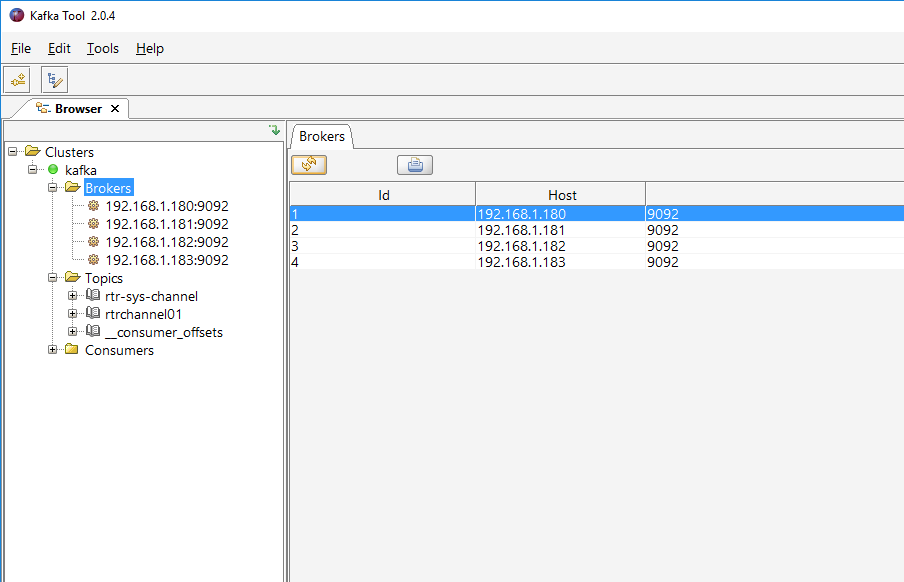
We can see the list of brokers , Topics , partitions .The Topics are the system channel and the channel we created and selecting channel shows the leader broker id =0.
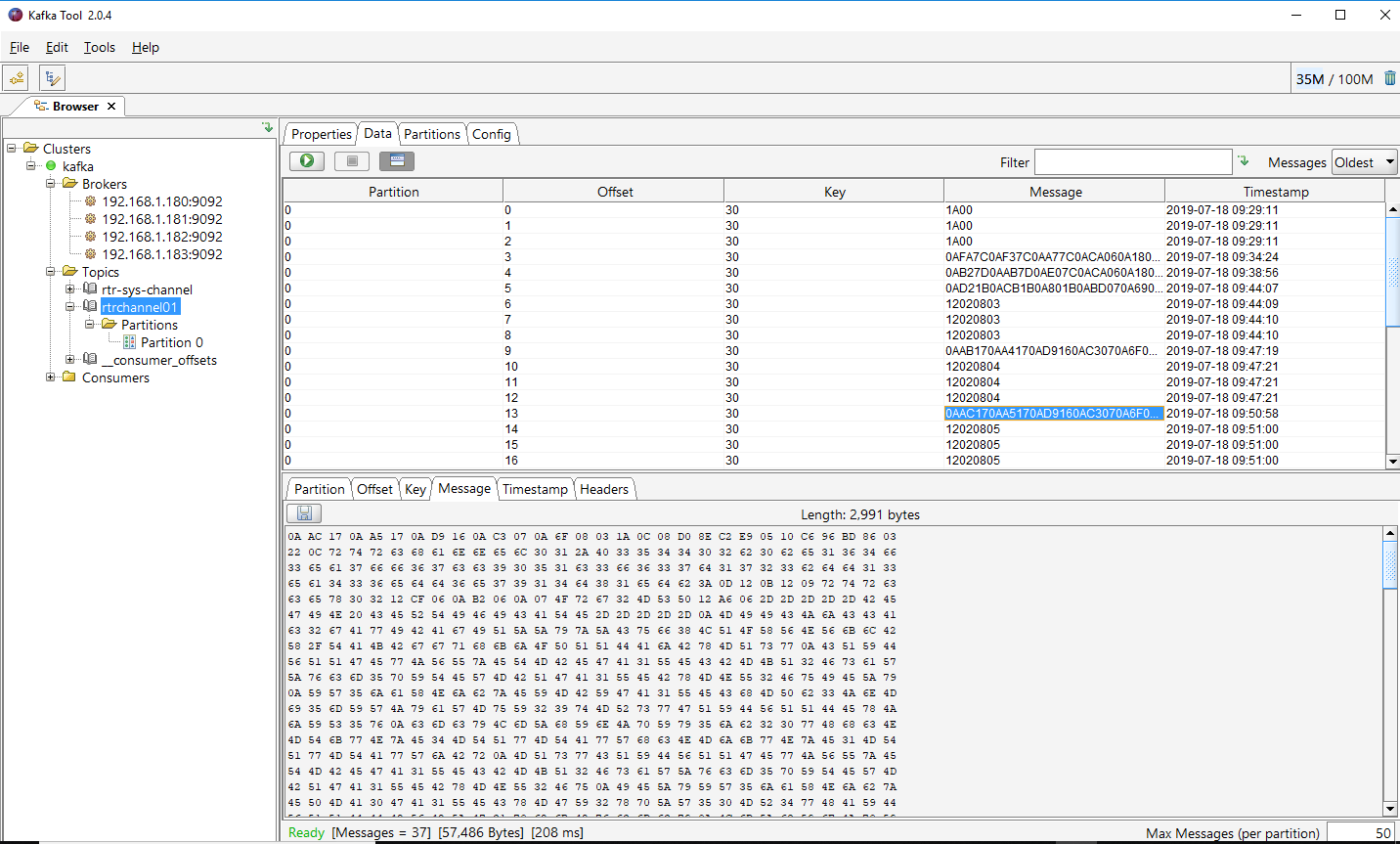
Partition data tab
Partition data tab shows messages and their keys in the partitions of channel topics. For chaincode invoke transaction we can see messages being produced under topic channel name.
Kafkat :- You can also use kafkat commands to see information in CLI .
# kafkat commands
kafkat brokers
kafkat partitions # Shows Topics ,Partition , Leader , Replicas
kafkat topics
You can also run the ‘kafkat partitions’ command to the see the results below which shows topics which are channels leader,replicas.

Kafka verify leader election.
Before :- Number of Brokers =4 ,Current Leader IP 183

# Lets stop the leader run this command on leader node
kafka/bin/kafka-server-stop.sh
After :- Number of Brokers =3 ,New Leader IP 182
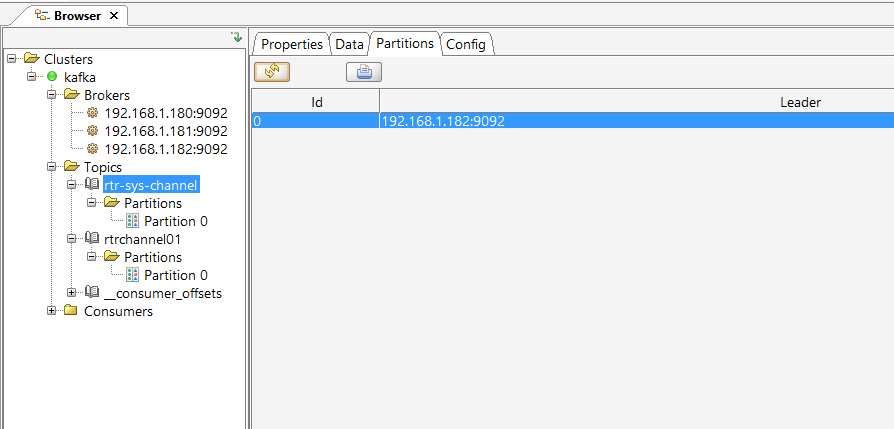
References
https://medium.com/beyondi/understanding-hyperledger-explorer-setup-via-docker-6af845fcb82e
http://www.kafkatool.com/features.html
https://www.digitalocean.com/community/tutorials/how-to-install-apache-kafka-on-centos-7
https://hyperledger-fabric.readthedocs.io/en/latest/kafka.html#steps